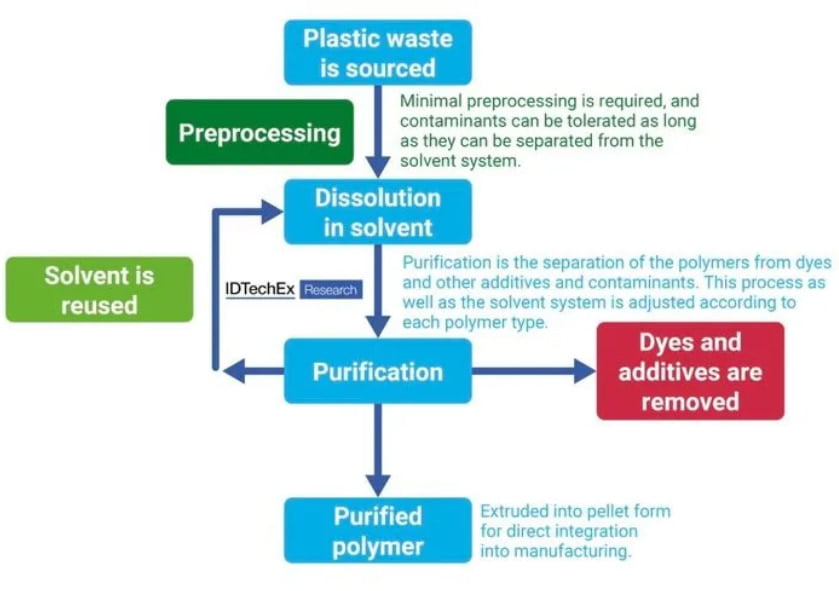Currently, the advanced plastics recycling market is focused on technologies such as pyrolysis and depolymerization (thermal, chemical and enzymatic), with some exploring methods such as gasification and hydrothermal liquefaction. However, these technologies are facing increasing scrutiny and restrictions in some regions due to their environmental impacts. Although mechanical recovery is the preferred recovery method due to its cost-effectiveness and efficiency, it still falls short in applications requiring high purity and mechanical properties. To address these challenges posed by chemical and mechanical recovery technologies, dissolution technology (sometimes referred to as solvent extraction) offers a promising solution.
Understanding the dissolution process
Dissolution involves the use of solvents to separate polymer wastes. The solvent selectively dissolves the polymer, separating it from contaminants and other non-target materials. After dissolution, the solution is purified and the solvents are removed, leaving a nearly pure plastic that can be processed into pellets and reused in production. This method allows for the treatment of contaminated or mixed plastic wastes, which are difficult to recover by mechanical means, without breaking down the polymer into its constituent molecules or feedstocks. The need for careful separation of different polymer types is reduced because when the correct solvent mixture is used, the plastic types can be selectively dissolved and separated. These processes are designed with solvents and separation methods for specific plastic types such as polypropylene PP, polystyrene PS, and acrylonitrile butadiene styrene ABS.PureCycle Technologies is a well-known name in the field of plastics dissolution. The company utilizes a proprietary technology developed by Procter & Gamble to recycle polypropylene. The process involves the use of a solvent (primarily n-butane) to purify waste polypropylene into a form that is qualitatively comparable to virgin plastic. PureCycle says its recycled PP can be used in applications where mechanical recycling methods are not sufficient, such as food-grade packaging.PureCycle is currently the leading commercial-grade supplier in this area. The main advantage of dissolution over chemical recycling techniques is that it can provide higher total theoretical yields, as the product re-enters the plastics supply chain as a ready-to-use resin rather than a simple polymer building block or hydrocarbon.

General process of decomposition of plastic waste
Advances in Dissolution Research
As a relatively new industry, research and development of its processes continues. A prominent example is Solvent Targeted Recovery and Precipitation (STRAP), a new technology framework developed by researchers at the University of Wisconsin-Madison. The technology separates the components of multilayer plastic films and removes contaminants. Multilayer films are a key challenge in plastic waste management, so there is great potential for commercialization of this technology. In addition, the developers of STRAP claim that the process has a number of advantages over competitors, including operating at atmospheric pressure and lower temperatures. Michigan Technological University is currently building a small pilot plant to validate the technology. The promise of a highly adaptable dissolution system will be the most popular solution for this difficult-to-recycle plastic waste. The technical challenges of retractable belts could mean that this will take several years before commercial scale.
Future challenges of dissolution
Although the solubility technology is promising, it faces challenges and criticisms. For example, there are issues regarding long-term recycling, as polymers may degrade in successive cycles. Another issue with the dissolution process is the environmental impact of the solvents used. These chemicals must be carefully managed to avoid releasing hazardous substances into the environment. The energy required to heat the solvent and subsequently remove it from the dissolved plastic also increases the carbon footprint of the process. The economic viability of dissolution technologies also remains uncertain. The cost of solvents, energy consumption and the need for complex infrastructure may make polymers recovered from dissolution plants more expensive than with mechanical recovery methods. The size of this green premium compared to other recycling technologies will determine whether dissolution plants are economically viable. In addition, the scale required to make a significant impact on plastic waste through dissolution is enormous. Building the necessary infrastructure to treat large quantities of plastic waste through dissolution is a daunting task that requires significant capital investment and time.
The Future of the Dissolution Market
The success of dissolution technologies such as ureCycle depends on market demand for recycled plastics. While there is growing interest in sustainable materials, competition from cheaper virgin plastics may limit the market potential for recycled products. Future efforts will focus on the process of developing a wider range of polymer types. Companies such as APK, Worn Again and Polystyvert are working on polyethylene (PE), polyethylene terephthalate (PET) and polystyrene (PS) respectively. The Netherlands Organization for Applied Scientific Research (TNO) is developing a process called Mobius for recycling acrylonitrile butadiene styrene (ABS), although it is not yet commercially available. Dissolution is a promising technology to address the need for low-carbon, multifunctional plastic waste solutions. However, a number of barriers remain, including technological improvements, commercial scale and economic challenges. Stakeholders must carefully assess the pros and cons of dissolution in the broader context of global waste management strategies. Addressing economic challenges will be key, as price will be a determining factor for success, as companies adopting recycled polymers assess how much of a green premium they can afford. As part of a comprehensive effort to mitigate the environmental impacts of plastic waste, continued research, investment and regulatory support will be critical to refining the process and assessing its long-term viability.

